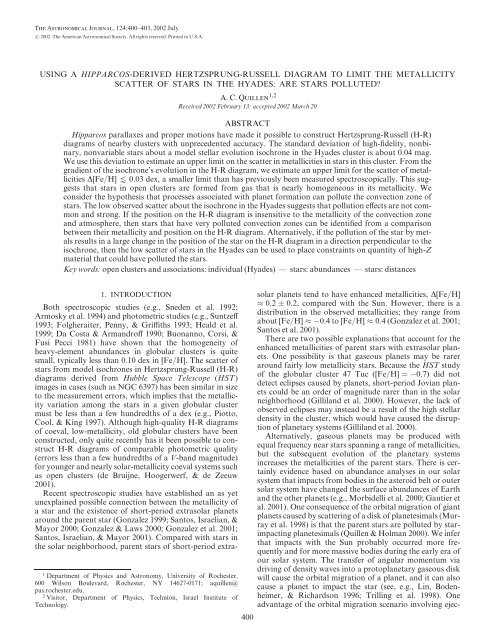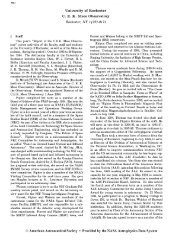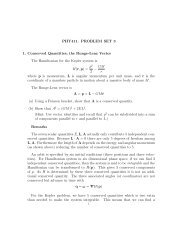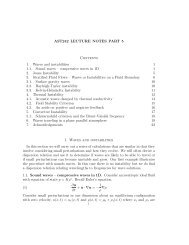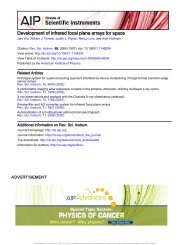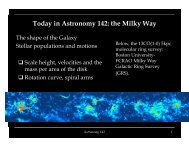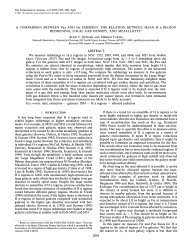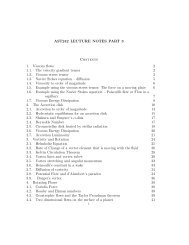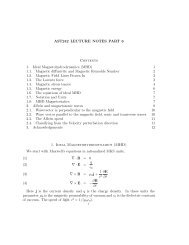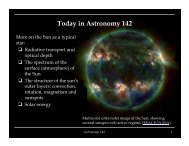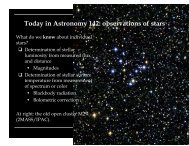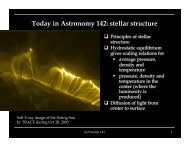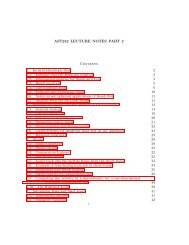are stars pollute - Astro Pas Rochester - University of Rochester
are stars pollute - Astro Pas Rochester - University of Rochester
are stars pollute - Astro Pas Rochester - University of Rochester
You also want an ePaper? Increase the reach of your titles
YUMPU automatically turns print PDFs into web optimized ePapers that Google loves.
The <strong>Astro</strong>nomical Journal, 124:400–403, 2002 July<br />
# 2002. The American <strong>Astro</strong>nomical Society. All rights reserved. Printed in U.S.A.<br />
USING A HIPPARCOS-DERIVED HERTZSPRUNG-RUSSELL DIAGRAM TO LIMIT THE METALLICITY<br />
SCATTER OF STARS IN THE HYADES: ARE STARS POLLUTED?<br />
A. C. Quillen 1,2<br />
Received 2002 February 13; accepted 2002 March 20<br />
ABSTRACT<br />
Hipparcos parallaxes and proper motions have made it possible to construct Hertzsprung-Russell (H-R)<br />
diagrams <strong>of</strong> nearby clusters with unprecedented accuracy. The standard deviation <strong>of</strong> high-fidelity, nonbinary,<br />
nonvariable <strong>stars</strong> about a model stellar evolution isochrone in the Hyades cluster is about 0.04 mag.<br />
We use this deviation to estimate an upper limit on the scatter in metallicities in <strong>stars</strong> in this cluster. From the<br />
gradient <strong>of</strong> the isochrone’s evolution in the H-R diagram, we estimate an upper limit for the scatter <strong>of</strong> metallicities<br />
D[Fe/H] d 0.03 dex, a smaller limit than has previously been measured spectroscopically. This suggests<br />
that <strong>stars</strong> in open clusters <strong>are</strong> formed from gas that is nearly homogeneous in its metallicity. We<br />
consider the hypothesis that processes associated with planet formation can <strong>pollute</strong> the convection zone <strong>of</strong><br />
<strong>stars</strong>. The low observed scatter about the isochrone in the Hyades suggests that pollution effects <strong>are</strong> not common<br />
and strong. If the position on the H-R diagram is insensitive to the metallicity <strong>of</strong> the convection zone<br />
and atmosphere, then <strong>stars</strong> that have very <strong>pollute</strong>d convection zones can be identified from a comparison<br />
between their metallicity and position on the H-R diagram. Alternatively, if the pollution <strong>of</strong> the star by metals<br />
results in a large change in the position <strong>of</strong> the star on the H-R diagram in a direction perpendicular to the<br />
isochrone, then the low scatter <strong>of</strong> <strong>stars</strong> in the Hyades can be used to place constraints on quantity <strong>of</strong> high-Z<br />
material that could have <strong>pollute</strong>d the <strong>stars</strong>.<br />
Key words: open clusters and associations: individual (Hyades) — <strong>stars</strong>: abundances — <strong>stars</strong>: distances<br />
1. INTRODUCTION<br />
Both spectroscopic studies (e.g., Sneden et al. 1992;<br />
Armosky et al. 1994) and photometric studies (e.g., Suntzeff<br />
1993; Folgheraiter, Penny, & Griffiths 1993; Heald et al.<br />
1999; Da Costa & Armandr<strong>of</strong>f 1990; Buonanno, Corsi, &<br />
Fusi Pecci 1981) have shown that the homogeneity <strong>of</strong><br />
heavy-element abundances in globular clusters is quite<br />
small, typically less than 0.10 dex in [Fe/H]. The scatter <strong>of</strong><br />
<strong>stars</strong> from model isochrones in Hertzsprung-Russell (H-R)<br />
diagrams derived from Hubble Space Telescope (HST)<br />
images in cases (such as NGC 6397) has been similar in size<br />
to the measurement errors, which implies that the metallicity<br />
variation among the <strong>stars</strong> in a given globular cluster<br />
must be less than a few hundredths <strong>of</strong> a dex (e.g., Piotto,<br />
Cool, & King 1997). Although high-quality H-R diagrams<br />
<strong>of</strong> coeval, low-metallicity, old globular clusters have been<br />
constructed, only quite recently has it been possible to construct<br />
H-R diagrams <strong>of</strong> comparable photometric quality<br />
(errors less than a few hundredths <strong>of</strong> a V-band magnitude)<br />
for younger and nearly solar-metallicity coeval systems such<br />
as open clusters (de Bruijne, Hoogerwerf, & de Zeeuw<br />
2001).<br />
Recent spectroscopic studies have established an as yet<br />
unexplained possible connection between the metallicity <strong>of</strong><br />
a star and the existence <strong>of</strong> short-period extrasolar planets<br />
around the p<strong>are</strong>nt star (Gonzalez 1999; Santos, Israelian, &<br />
Mayor 2000; Gonzalez & Laws 2000; Gonzalez et al. 2001;<br />
Santos, Israelian, & Mayor 2001). Comp<strong>are</strong>d with <strong>stars</strong> in<br />
the solar neighborhood, p<strong>are</strong>nt <strong>stars</strong> <strong>of</strong> short-period extra-<br />
1 Department <strong>of</strong> Physics and <strong>Astro</strong>nomy, <strong>University</strong> <strong>of</strong> <strong>Rochester</strong>,<br />
600 Wilson Boulevard, <strong>Rochester</strong>, NY 14627-0171; aquillen@<br />
pas.rochester.edu.<br />
2 Visitor, Department <strong>of</strong> Physics, Technion, Israel Institute <strong>of</strong><br />
Technology.<br />
400<br />
solar planets tend to have enhanced metallicities, D[Fe/H]<br />
0.2 0.2, comp<strong>are</strong>d with the Sun. However, there is a<br />
distribution in the observed metallicities; they range from<br />
about [Fe/H] 0.4 to [Fe/H] 0.4 (Gonzalez et al. 2001;<br />
Santos et al. 2001).<br />
There <strong>are</strong> two possible explanations that account for the<br />
enhanced metallicities <strong>of</strong> p<strong>are</strong>nt <strong>stars</strong> with extrasolar planets.<br />
One possibility is that gaseous planets may be r<strong>are</strong>r<br />
around fairly low metallicity <strong>stars</strong>. Because the HST study<br />
<strong>of</strong> the globular cluster 47 Tuc ([Fe/H] = 0.7) did not<br />
detect eclipses caused by planets, short-period Jovian planets<br />
could be an order <strong>of</strong> magnitude r<strong>are</strong>r than in the solar<br />
neighborhood (Gilliland et al. 2000). However, the lack <strong>of</strong><br />
observed eclipses may instead be a result <strong>of</strong> the high stellar<br />
density in the cluster, which would have caused the disruption<br />
<strong>of</strong> planetary systems (Gilliland et al. 2000).<br />
Alternatively, gaseous planets may be produced with<br />
equal frequency near <strong>stars</strong> spanning a range <strong>of</strong> metallicities,<br />
but the subsequent evolution <strong>of</strong> the planetary systems<br />
increases the metallicities <strong>of</strong> the p<strong>are</strong>nt <strong>stars</strong>. There is certainly<br />
evidence based on abundance analyses in our solar<br />
system that impacts from bodies in the asteroid belt or outer<br />
solar system have changed the surface abundances <strong>of</strong> Earth<br />
and the other planets (e.g., Morbidelli et al. 2000; Gautier et<br />
al. 2001). One consequence <strong>of</strong> the orbital migration <strong>of</strong> giant<br />
planets caused by scattering <strong>of</strong> a disk <strong>of</strong> planetesimals (Murray<br />
et al. 1998) is that the p<strong>are</strong>nt <strong>stars</strong> <strong>are</strong> <strong>pollute</strong>d by starimpacting<br />
planetesimals (Quillen & Holman 2000). We infer<br />
that impacts with the Sun probably occurred more frequently<br />
and for more massive bodies during the early era <strong>of</strong><br />
our solar system. The transfer <strong>of</strong> angular momentum via<br />
driving <strong>of</strong> density waves into a protoplanetary gaseous disk<br />
will cause the orbital migration <strong>of</strong> a planet, and it can also<br />
cause a planet to impact the star (see, e.g., Lin, Bodenheimer,<br />
& Richardson 1996; Trilling et al. 1998). One<br />
advantage <strong>of</strong> the orbital migration scenario involving ejec-
METALLICITY IN THE HYADES 401<br />
tion <strong>of</strong> planetesimals comp<strong>are</strong>d with that involving density<br />
waves driven into a gaseous disk is that it <strong>pollute</strong>s the <strong>stars</strong><br />
with metal-rich planetary material when they <strong>are</strong> older and,<br />
so, have smaller convection zones (see, e.g., Laughlin &<br />
Adams 1997), allowing a smaller amount <strong>of</strong> metals to cause<br />
a larger surface metallicity enrichment.<br />
Because the fraction <strong>of</strong> mass in the convection zone<br />
depends on the stellar mass, higher mass <strong>stars</strong> (e.g., F <strong>stars</strong>)<br />
with smaller convection zones could be more likely than<br />
lower mass <strong>stars</strong> with larger convection zones (e.g., K <strong>stars</strong>)<br />
to have enhanced metallicities resulting from pollution<br />
caused by planetary material. However, Pinsonneault,<br />
DePoy, & C<strong>of</strong>fee (2001) find no such trend among the<br />
p<strong>are</strong>nt <strong>stars</strong> <strong>of</strong> extrasolar planets. Santos et al. (2001) find<br />
that the distribution <strong>of</strong> metallicities for p<strong>are</strong>nt <strong>stars</strong> <strong>of</strong> extrasolar<br />
planets is inconsistent with a model in which these<br />
<strong>stars</strong> have been <strong>pollute</strong>d by the addition <strong>of</strong> high-Z material.<br />
Except for a narrow region at 6500 300 K, known as<br />
the lithium dip, F <strong>stars</strong> keep lithium on their surface nearly<br />
their entire lifetime (see Balachandran 1995; Soderblom et<br />
al. 1993). The absence <strong>of</strong> Li depletion implies that the convection<br />
zone does not mix with the interior <strong>of</strong> the star except<br />
within the lithium dip. For F <strong>stars</strong> outside the lithium dip,<br />
little mixing takes place and a metallicity enhancement<br />
would last nearly the entire lifetime <strong>of</strong> the star; however, F<br />
<strong>stars</strong> within the dip would not be expected to show metallicity<br />
enhancements. Murray et al. (2001) and Murray & Chaboyer<br />
(2002) suggest that F <strong>stars</strong> near the lithium dip tend<br />
to have lower metallicities than F <strong>stars</strong> outside the lithium<br />
dip.<br />
The stellar sample studied by Murray et al. (2001) and<br />
Murray & Chaboyer (2002) and surveyed for planets draws<br />
on the population <strong>of</strong> <strong>stars</strong> in the solar neighborhood and so<br />
spans a large range in ages and metallicities. To try to<br />
decouple the uncertainty caused by the metallicity scatter<br />
resulting from the range <strong>of</strong> stellar ages in the solar neighborhood<br />
from that caused by planet formation, we can examine<br />
the metallicity scatter in young clusters. We can assume that<br />
the <strong>stars</strong> in a given stellar cluster <strong>are</strong> the same age and were<br />
formed from gas that was fairly uniform in metallicity. Stars<br />
in the solar neighborhood <strong>are</strong> expected to have been born in<br />
a variety <strong>of</strong> environments, with about 10% born in OB associations,<br />
which then can become bound open clusters (Roberts<br />
1957). The low-eccentricity orbits <strong>of</strong> the solar system<br />
planets require that the birth aggregate <strong>of</strong> the Sun was less<br />
than a few thousand <strong>stars</strong> (Adams & Laughlin 2001) and<br />
similar in size to the Trapezium cluster. Open clusters such<br />
as the Hyades, with about 400 known members, could have<br />
been as large as the Trapezium when younger.<br />
Based on the study <strong>of</strong> Adams & Laughlin (2001), we<br />
expect that short-period extrasolar planets should have a<br />
high probability <strong>of</strong> surviving disruption from the passage <strong>of</strong><br />
nearby <strong>stars</strong> in open clusters. Despite the fact that most<br />
<strong>stars</strong> in the solar neighborhood were formed in smaller,<br />
unbound groups, since planetary systems <strong>are</strong> likely to survive<br />
in open clusters we can use observations <strong>of</strong> the <strong>stars</strong> in<br />
open clusters to explore the possibility that significant stellar<br />
metallicity enhancements (pollution) <strong>are</strong> likely to occur<br />
after a star is formed. If metallicity enhancements occur,<br />
they would occur over a fairly short timescale, 10 6 yr for<br />
the orbital migration scenario involving density waves in a<br />
gaseous disk (Trilling et al. 1998), and 10 7 yr for the migration<br />
scenario involving scattering <strong>of</strong> planetesimals (Murray<br />
et al. 1998). In open clusters, planetary systems should survive<br />
long enough that they could have caused metallicity<br />
enhancements. Furthermore, nearby open clusters have<br />
nearly solar metallicities and so <strong>are</strong> a better match to the<br />
properties <strong>of</strong> p<strong>are</strong>nt <strong>stars</strong> <strong>of</strong> extrasolar planets than <strong>are</strong><br />
the <strong>stars</strong> in globular clusters, which <strong>are</strong> comparatively<br />
extremely metal-poor.<br />
It is difficult to envision any planet formation mechanism<br />
that would not cause differing amounts <strong>of</strong> metallicity pollution<br />
in different solar systems. We therefore expect a scatter<br />
in the metallicities in individual <strong>stars</strong> in any given stellar<br />
cluster and, so, a scatter in the H-R diagram about an isochrone.<br />
We might also expect a reduction in [C/Fe] because<br />
the inner solar system is deficient in light elements such as<br />
carbon. However, despite earlier reports, low values <strong>of</strong> [C/<br />
Fe] <strong>are</strong> not observed in the p<strong>are</strong>nt <strong>stars</strong> <strong>of</strong> the short-period<br />
extrasolar planets (Santos et al. 2001; Gonzalez et al. 2001).<br />
If ice-rich cometary material from the outer solar system is<br />
incorporated into the star on a later timescale, it is possible<br />
that light-element abundances could be restored. However,<br />
this could only occur if material from the outer solar system<br />
can survive evaporation. Evaporation rates <strong>are</strong> higher near<br />
the high-mass and more luminous <strong>stars</strong>; however, these<br />
<strong>stars</strong>, because <strong>of</strong> their lower mean densities, <strong>are</strong> also less<br />
likely to cause objects to fragment. Smaller sized bodies,<br />
because <strong>of</strong> their larger surface <strong>are</strong>a, <strong>are</strong> less likely to achieve<br />
final impact, particularly after a series <strong>of</strong> close approaches,<br />
which can be caused by resonant trapping (Quillen &<br />
Holman 2000).<br />
Spectroscopic studies <strong>of</strong> F <strong>stars</strong> in individual open clusters<br />
and moving groups have found that the metallicity scatter<br />
is small, D[Fe/H] d 0.1 (Boesgaard & Friel 1990; Friel<br />
& Boesgaard 1990, 1992). These authors also measured no<br />
measurable variation in the [C/Fe] ratio among all <strong>stars</strong> in<br />
all clusters studied. These studies would appear to rule out<br />
significant metallicity enhancement resulting from planet<br />
formation and subsequent planetary evolution in most<br />
<strong>stars</strong>. However, the number <strong>of</strong> F <strong>stars</strong> observed in each cluster<br />
in these studies was not more than a dozen. Establishing<br />
cluster membership is not always unambiguous, and so the<br />
samples <strong>of</strong> <strong>stars</strong> chosen for detailed spectroscopic study<br />
were not complete.<br />
2. A LIMIT IN THE METALLICITY SCATTER FROM<br />
THE HYADES CLUSTER H-R DIAGRAM<br />
Hipparcos parallaxes and proper motions have made it<br />
possible to construct H-R diagrams <strong>of</strong> nearby clusters with<br />
unprecedented accuracy (de Bruijne et al. 2001). With<br />
improved distances and a sample <strong>of</strong> 92 high-fidelity cluster<br />
<strong>stars</strong>, de Bruijne et al. have constructed an H-R diagram<br />
with estimated errors in the logarithm <strong>of</strong> the luminosity in<br />
solar units that average 0.030. The high-fidelity sample<br />
excludes members beyond 40 pc from the cluster center,<br />
multiple <strong>stars</strong>, variable <strong>stars</strong>, and <strong>stars</strong> with peculiar or<br />
uncertain parallaxes (see x 9.3 <strong>of</strong> de Bruijne et al. 2001).<br />
Stars were not excluded based on their position in the<br />
H-R diagram.<br />
We show in Figure 1, as data points, the difference<br />
between the positions <strong>of</strong> the <strong>stars</strong> on the H-R diagram and<br />
the 630 Myr evolutionary track at Z = 0.024 interpolated<br />
from those given as tables by Girardi et al. (2000). The mean<br />
difference between the track and <strong>stars</strong> is not zero. This<br />
implies that the evolutionary track is not a perfect match to<br />
the H-R diagram <strong>of</strong> the cluster. It is impressive that the H-R
402 QUILLEN Vol. 124<br />
0.2<br />
0.1<br />
-0.1<br />
0<br />
3.9 3.8 3.7 3.6<br />
log(Teff[K])<br />
Fig. 1.—Difference between the 92 high-fidelity clusters Hyades <strong>stars</strong><br />
identified by de Bruijne et al. (2001) and the Z = 0.024, 630 Myr evolutionary<br />
track <strong>of</strong> Girardi et al. (2000). We use temperatures and luminosities<br />
derived by de Bruijne et al. The scatter from the mean has a standard deviation<br />
<strong>of</strong> = 0.04 in the logarithm <strong>of</strong> the luminosity. Solid line, difference<br />
between coeval evolution tracks that differ by 0.1 dex in [Fe/H]; dotted line,<br />
position <strong>of</strong> the lithium dip in the Hyades.<br />
diagram is so good that the evolutionary tracks (and associated<br />
bolometric corrections and color–to–effective temperature<br />
calibrations) can be tested to the level <strong>of</strong> 0.05 in the<br />
logarithm <strong>of</strong> the luminosity. Nevertheless, trends or smooth<br />
deviations from zero on this plot <strong>are</strong> not important for our<br />
study, since we <strong>are</strong> primarily interested in the scatter <strong>of</strong> the<br />
points. The age differences in the <strong>stars</strong> should be small comp<strong>are</strong>d<br />
with the age <strong>of</strong> the cluster, so other than observational<br />
errors, the variations in the stellar metallicities <strong>are</strong> the<br />
primary factor that would cause a scatter in the position <strong>of</strong><br />
the points on the H-R diagram about the isochrone.<br />
One can see from Figure 1 that the scatter <strong>of</strong>f the evolutionary<br />
track is less than 0.05 in the logarithm <strong>of</strong> the luminosity<br />
comp<strong>are</strong>d with the mean local value. However, an<br />
evolutionary track that differs by 0.1 dex in [Fe/H] (Fig. 1,<br />
solid line) is <strong>of</strong>fset by about 0.15 in the logarithm <strong>of</strong> the luminosity.<br />
We therefore estimate that the star-to-star differences<br />
in metallicity could be only as large as 0.03 dex in<br />
[Fe/H]. This is only a bit larger than that estimated for the<br />
solar neighborhood by Murray et al. (2001), 0.02 dex, corresponding<br />
to 0.5 M <strong>of</strong> accreted iron from the inner solar<br />
system. This limit for the standard deviation <strong>of</strong> 0.03 dex in<br />
[Fe/H] is better than that previously estimated by Boesgaard<br />
& Friel (1990) from less than a dozen F <strong>stars</strong>, which<br />
was roughly 0.1 dex. This low level <strong>of</strong> scatter in the metallicities<br />
suggests that the gas from which the <strong>stars</strong> form is quite<br />
homogeneous in metallicity. Because massive <strong>stars</strong> become<br />
supernovae well before low-mass <strong>stars</strong> <strong>are</strong> finished accreting,<br />
this limit also suggests that nearby supernovae <strong>are</strong> not<br />
capable <strong>of</strong> substantially enriching the interstellar medium in<br />
their own nearby star-forming regions.<br />
Stellar isochrones <strong>are</strong> computed assuming that <strong>stars</strong> do<br />
not accrete additional high-Z material after formation.<br />
Comp<strong>are</strong>d with a star that has not accreted additional material,<br />
where would we expect such a star to lie on the H-R diagram<br />
in the cluster? To know the answer to this question,<br />
we would need to calculate additional stellar evolutionary<br />
tracks from stellar models. While the properties <strong>of</strong> the radiative<br />
zone might be similar because it would have the same<br />
metallicity, and the energy transport through the convection<br />
should not be strongly affected by the opacity, the stellar atmosphere<br />
would be redder, and since this sets the boundary<br />
condition for the stellar model, we do not expect the star to<br />
lie at exactly the same position on the H-R diagram.<br />
We consider two possibilities: (1) The position in the H-R<br />
diagram for a star that has accreted high-Z material is similar<br />
to that <strong>of</strong> one that has not. (2) There is a significant<br />
difference in the location on the H-R diagram and in a direction<br />
that would distance the star <strong>of</strong>f the isochrone. If the first<br />
possibility is true, then we suggest that spectroscopic<br />
analyses can be used to identify candidate <strong>stars</strong> that have<br />
higher metallicities than would be expected from their positions<br />
on the H-R diagram. If such <strong>stars</strong> <strong>are</strong> found, it<br />
would provide strong evidence that they had been <strong>pollute</strong>d<br />
by high-Z material after formation, and by processes associated<br />
with planet formation.<br />
If the second possibility is likely, then we emphasize that<br />
the scatter from the isochrone observed in the H-R diagram<br />
can be used to constrain stellar pollution scenarios. Since<br />
the level <strong>of</strong> scatter has a standard deviation about 0.03 dex<br />
in [Fe/H], the average star could only have accreted about<br />
0.7 M <strong>of</strong> accreted iron from the inner solar system.<br />
Only a few <strong>stars</strong> remain outside the local mean in Figure 1<br />
with deviations greater than 0.05 in the logarithm <strong>of</strong> the<br />
luminosity. However, <strong>stars</strong> with short-period giant planets<br />
<strong>are</strong> fairly common. In the solar neighborhood, 6%–8% <strong>of</strong><br />
solar-type <strong>stars</strong> have short-period giant extrasolar planets<br />
(Mayor & Queloz 1995; Marcy, Cochran, & Mayor 2000).<br />
Of the 92 high-fidelity <strong>stars</strong>, we expect 6 2 with significantly<br />
higher metallicities. None <strong>of</strong> the <strong>stars</strong> is sufficiently<br />
<strong>of</strong>f the evolutionary track that an enhancement <strong>of</strong> 0.1–0.2<br />
dex could be allowed. This would suggest that no star in the<br />
Hyades is likely to have a metallicity enhanced by the 30 M <br />
<strong>of</strong> rocky material needed to account for the enhanced metallicities<br />
<strong>of</strong> the p<strong>are</strong>nt <strong>stars</strong> <strong>of</strong> short-period extrasolar planets<br />
(Murray et al. 2001; Laughlin 2000; Murray & Chaboyer<br />
2002), unless these <strong>stars</strong> happen to lie exactly on the same<br />
isochrone as their non<strong>pollute</strong>d counterparts.<br />
We have checked that there is no correlation between the<br />
magnitude <strong>of</strong> the scatter in the H-R diagram and the<br />
amount <strong>of</strong> lithium for the 19 F <strong>stars</strong> in the high-fidelity<br />
sample <strong>of</strong> de Bruijne et al. (2001) that have lithium abundances<br />
listed by Boesgaard (1987) or Thorburn et al. (1993).<br />
Even though the scatter in Figure 1 seems to peak near the<br />
lithium dip, the level <strong>of</strong> scatter does not seem to be obviously<br />
related to the mixing below the convection zone, as we<br />
would expect if it were correlated with the lithium abundance.<br />
We find no relation between the scatter <strong>of</strong>f the<br />
isochrone and the effective temperature <strong>of</strong> the star, as would<br />
be expected from a pollution model that is sensitive to the<br />
percentage <strong>of</strong> mass within the convection zone.<br />
3. DISCUSSION<br />
In this paper, we have used the high-quality H-R diagram<br />
<strong>of</strong> the Hyades to place limits on the scatter in the metallicities<br />
<strong>of</strong> this cluster. We find that the scatter in [Fe/H] has a
No. 1, 2002 METALLICITY IN THE HYADES 403<br />
standard deviation <strong>of</strong> approximately 0.03 dex. This estimate<br />
is an improvement upon previous spectroscopic estimates<br />
and suggests that open clusters <strong>are</strong> formed from gas that is<br />
homogeneous in metallicity.<br />
We have introduced the possibility that the extremely low<br />
scatter from a predicted isochrone can be used to constrain<br />
stellar pollution scenarios that involve the addition <strong>of</strong> high-<br />
Z material to the star from processes associated with planet<br />
formation. This can be done if stellar evolution tracks <strong>are</strong><br />
calculated that include the addition <strong>of</strong> high-Z metals after<br />
formation to see where <strong>stars</strong> lie on the H-R diagram. If <strong>pollute</strong>d<br />
<strong>stars</strong> lie <strong>of</strong>f the isochrone for un<strong>pollute</strong>d <strong>stars</strong>, then the<br />
scatter <strong>of</strong> <strong>stars</strong> in the H-R diagram can be used to constrain<br />
the extent <strong>of</strong> stellar pollution. Otherwise, comparisons<br />
between spectroscopically measured metallicities and those<br />
estimated from the mean properties <strong>of</strong> the cluster can be<br />
used to identify <strong>stars</strong> that <strong>are</strong> likely to have been <strong>pollute</strong>d by<br />
high-Z material.<br />
Since few <strong>stars</strong> in young clusters have had comprehensive<br />
metallicity analyses, subsequent studies could be expanded<br />
and verified, also including more <strong>stars</strong> with a larger range <strong>of</strong><br />
mass. C<strong>are</strong> should be taken that <strong>stars</strong> with discrepant metallicities<br />
<strong>are</strong> not thrown out <strong>of</strong> the sample and assumed to be<br />
non–cluster members. Currently there is no observational<br />
evidence that metallicities <strong>of</strong> different-mass <strong>stars</strong> in a given<br />
cluster differ. Comparison <strong>of</strong> spectroscopically measured<br />
metallicities in the Hyades, Pleiades, and NGC 2264<br />
between G and F <strong>stars</strong> find that the metallicities <strong>are</strong> the<br />
same within the observational uncertainties (approximately<br />
0.1 dex; King et al. 2000; Boesgaard & Friel 1990).<br />
Despite the fact that the interstellar medium (along 1 kpc<br />
line-<strong>of</strong>-sight absorption lines) appears to have a uniform<br />
metallicity (Meyer, Jura, & Cardelli 1998), the metallicities<br />
<strong>of</strong> moving groups differ significantly (Boesgaard & Friel<br />
1990; Friel & Boesgaard 1990), and the youngest ones seem<br />
to have increasingly subsolar values. There also <strong>are</strong><br />
extremely metal-rich <strong>stars</strong>, some <strong>of</strong> which <strong>are</strong> not young.<br />
The high-metallicity <strong>stars</strong> <strong>are</strong> kinematically related; they<br />
tend to be in moving groups or streams (Soubiran 1999).<br />
This suggests that high-metallicity <strong>stars</strong> <strong>are</strong> formed in clusters<br />
that <strong>are</strong> uniform in metallicity, just like lower metallicity<br />
<strong>stars</strong>. This may rule out a scenario in which even a few<br />
percent <strong>of</strong> <strong>stars</strong> have their metallicity increased significantly<br />
by the effects <strong>of</strong> planetary processes and would instead support<br />
a model in which higher metallicity <strong>stars</strong> <strong>are</strong> more<br />
likely to harbor short-period planets. However, there is<br />
good evidence that one p<strong>are</strong>nt star <strong>of</strong> an extrasolar planet<br />
has engulfed planetary material: the detection <strong>of</strong> 6 Li in<br />
HD 82943 (Israelian et al. 2001; for evolutionary scenarios,<br />
see Sandquist et al. 2002). Further study <strong>of</strong> uniform populations<br />
such as <strong>are</strong> found in young clusters may be able<br />
to determine the relative statistical importance <strong>of</strong> each<br />
scenario.<br />
This work could not have been carried out without helpful<br />
discussions with Don Garnett, Caty Pilachowski, Jonathan<br />
Lunine, Bill Forest, Ari Laor, Patrick Young, Dave<br />
Arnett, Adam Burrows, Nadya Gorlova, and Mike Meyer.<br />
I thank Joss de Bruijne for providing me with information<br />
on the high-fidelity Hyades sample. A. C. Q. gratefully<br />
acknowledges hospitality and support as a visitor at the<br />
Technion.<br />
Adams, F. C., & Laughlin, G. 2001, Icarus, 150, 151<br />
Armosky, B. J., Sneden, C., Langer, G. E., & Kraft, R. P. 1994, AJ, 108,<br />
1364<br />
Balachandran, S. 1995, ApJ, 446, 203<br />
Boesgaard, A. M. 1987, PASP, 99, 1067<br />
Boesgaard, A. M., & Friel, E. D. 1990, ApJ, 351, 467<br />
Buonanno, R., Corsi, C. E., & Fusi Pecci, F. 1981, MNRAS, 196, 435<br />
Da Costa, G. S., & Armandr<strong>of</strong>f, T. E. 1990, AJ, 100, 162<br />
de Bruijne, J. H. J., Hoogerwerf, R., & de Zeeuw, P. T. 2001, A&A, 367,<br />
111<br />
Folgheraiter, E. L., Penny, A. J., & Griffiths, W. K. 1993, MNRAS, 264,<br />
991<br />
Friel, E. D., & Boesgaard, A. M. 1990, ApJ, 351, 480<br />
———. 1992, ApJ, 387, 170<br />
Gautier, D., Hersant, F., Mousis, O., & Lunine, J. I. 2001, ApJ, 550, L227<br />
(erratum 559, L183)<br />
Gilliland, R. L., et al. 2000, ApJ, 545, L47<br />
Girardi, L., Bressan, A., Bertelli, G., & Chiosi, C. 2000, A&AS, 141, 371<br />
Gonzalez, G. 1999, MNRAS, 308, 447<br />
Gonzalez, G., & Laws, C. 2000, AJ, 119, 390<br />
Gonzalez, G., Laws, C., Tyagi, S., & Reddy, B. E. 2001, AJ, 121, 432<br />
Heald, A. J., Griffiths, W. K., Penny, A. J., & Morris, P. W. 1999, MNRAS,<br />
307, 789<br />
King, J. R., Soderblom, D. R., Fischer, D., & Jones, B. F. 2000, ApJ, 533,<br />
944<br />
Israelian, G., Santos, N. C., Mayor, M., & Rebolo, R. 2001, Nature, 411,<br />
163<br />
Laughlin, G. 2000, ApJ, 545, 1064<br />
Laughlin, G., & Adams, F. C. 1997, ApJ, 491, L51<br />
Lin, D. N. C., Bodenheimer, P., & Richardson, D. C. 1996, Nature, 380,<br />
606<br />
REFERENCES<br />
Marcy, G. W., Cochran, W. D., & Mayor, M. 2000, in Proto<strong>stars</strong> and Planets<br />
IV, ed. V. Mannings, A. P. Boss, & S. S. Russell (Tucson: Univ.<br />
Arizona Press), 1285<br />
Mayor, M., & Queloz, D. 1995, Nature, 378, 355<br />
Meyer, D. M., Jura, M., & Cardelli, J. A. 1998, ApJ, 493, 222<br />
Morbidelli, A., Chambers, J., Lunine, J. I., Petit, J. M., Robert, F.,<br />
Valsecchi, G. B., & Cyr, K. E. 2000, Meteoritics Planet. Sci., 35, 1309<br />
Murray, N., & Chaboyer, B. 2002, ApJ, 566, 442<br />
Murray, N., Chaboyer, B., Arras, P., Hansen, B., & Noyes, R. W. 2001,<br />
ApJ, 555, 801<br />
Murray, N., Hansen, B., Holman, M., & Tremaine, S. 1998, Science, 279,<br />
69<br />
Pinsonneault, M. H., DePoy, D. L., & C<strong>of</strong>fee, M. 2001, ApJ, 556, L59<br />
Piotto, G., Cool, A. M., & King, I. R. 1997, AJ, 113, 1345<br />
Quillen, A. C., & Holman, M. 2000, AJ, 119, 397<br />
Roberts, M. S. 1957, PASP, 69, 59<br />
Sandquist, E. L., Dokter, J. J., Lin, D. N. C., & Mardling, M. A. 2002,<br />
ApJ, in press<br />
Santos, N. C., Israelian, G., & Mayor, M. 2000, A&A, 363, 228<br />
———. 2001, A&A, 373, 1019<br />
Sneden, C., Kraft, R. P., Prosser, C. F., & Langer, G. E. 1992, AJ, 104,<br />
2121<br />
Soderblom, D. R., Jones, B. F., Balachandran, S., Stauffer, J. R., Duncan,<br />
D. K., Fedele, S. B., & Hudon, J. D. 1993, AJ, 106, 1059<br />
Soubiran, C. 1999, Ap&SS, 265, 353<br />
Suntzeff N. 1993, in ASP Conf. Ser. 48, The Globular Cluster–Galaxy Connection,<br />
ed. G. H. Smith & J. P. Brodie (San Francisco: ASP), 167<br />
Thorburn, J. A., Hobbs, L. M., Deliyannis, C. P., & Pinsonneault, M. H.<br />
1993, ApJ, 415, 150<br />
Trilling, D. E., Benz, W., Guillot, T., Lunine, J. I., Hubbard, W. B., &<br />
Burrows, A. 1998, ApJ, 500, 428


